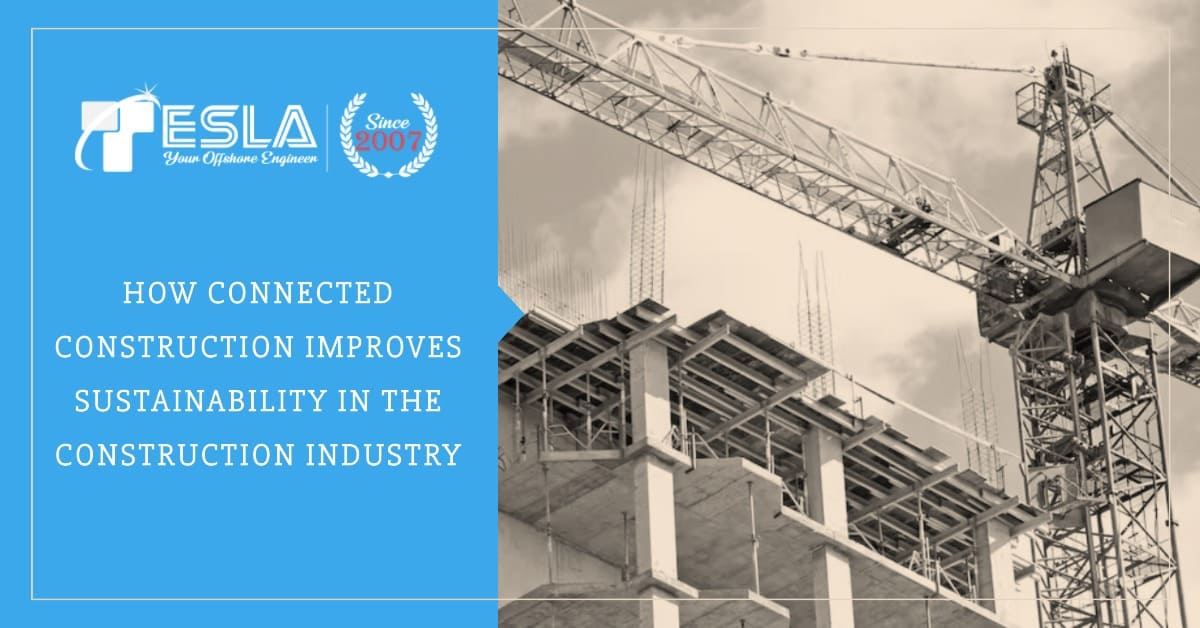The construction industry has historically shaped our world with transformative infrastructure. Its evolution is now entering a new era. This stage of the industry will be propelled by the same connectivity that has revolutionized how we interact through digital technologies. This paradigm shift is aptly named connected construction, an innovative approach that interlaces traditional practices with cutting-edge technologies.
Connected construction transcends the conventional boundaries of the building process. It involves the seamless integration of digital tools to create intelligent construction sites. As we navigate through the landscape of connected construction, we’ll unravel the significance of this technological advancement in fostering sustainability.
In a world grappling with environmental concerns, the role of connected construction becomes even more critical. The blog will delve into the ways in which this transformative approach addresses sustainability in construction practices, making it not just a technological advancement but a pressing need of our time. Join us on this exploration as we dissect the layers of connected construction, understanding how it emerges as a hope for a more sustainable future in the construction industry.
Understanding Connected Construction
Connected construction refers to the use of technology to create a network that connects construction professionals, tools, equipment and processes to streamline workflows. It uses different technologies such as BIM, Mobile devices, Internet of things, cloud computing etc. to improve collaboration between all the stakeholders through real time data sharing.
This is done by making all information about a construction project accessible through a powerful centralized dashboard which drastically reduces the time and effort it takes to find any information or to validate if the information is correct or not.
All details can be monitored and controlled centrally using cloud-based technology. Connected construction dashboards can give instantaneous access to 2D drawings or 3D BIM models at any location, they also help to create and fulfill information requests much faster. Here are some of the major benefits of Connected construction:
Improved communication and transparency:
Connected construction allows for improved active communication—for example, a construction worker can report back any site issues to supervisor via a smart mobile device. It also improved passive communication using sensors and tags integrated in vehicles and equipment. If someone wants to know where specific equipment or machinery is and if it needs fuel or maintenance? All that information will be available instantaneously.
Reduced Risk:
Connected construction reduces unexpected setbacks by removing many unknown variables. With the real-time access of inventory, staffing, and budget updates shared between all stakeholders on a single centralized platform, the chances of a construction project going over budget, past deadline, or failing are greatly reduced. If issues arise, they can be addressed before negatively affecting the viability of the project.
Accurate construction timelines:
Connected construction helps to convert different estimates into usable data, which improves timelines and budgets for a project. Instead of estimating when a key deliverable will be finished, connected construction technology helps site managers and construction teams to know exactly when one phase of a construction project is completed and when the next phase can begin.
How does connected construction help to improve sustainability?
According to a report the construction amounts for nearly 25 percent of the total greenhouse gases emission. With the global population projected to reach 10 billion by 2050 these emissions will only increase. Source Connected construction can play a big role in cutting these emissions as it leads to a more efficient construction process minimizing wastages of all kinds. Here are some of the ways connected construction can help in creating a more sustainable construction ecosystem.
Efficient Resource Utilization:
Connected construction optimizes material usage by employing design and analytics tools early in the process. Accurate calculations help prevent over-ordering and waste, reducing the environmental impact caused by excessive resource consumption. Real-time tracking ensures materials are efficiently utilized during construction, minimizing misplacements or losses and contributing to sustainable practices.
Waste Reduction through Prefabrication:
Prefabrication and modular construction done with the help of Steel Detailing Services are integral to connected construction. These practices curb environmental strain by reducing construction waste. Manufacturing components off-site allows for precise planning, minimizing excess material and enhancing quality control. This method not only accelerates the construction process but also aligns with sustainable building practices, fostering longevity and adaptability.
Enhanced Building Performance with BIM:
Detailed 3D models created by BIM Modeling Services aid in sustainable construction by optimizing space and resource utilization. BIM reduces waste, improves building performance, and supports eco-friendly construction practices. The intelligent integration of technology ensures energy-efficient designs, contributing to overall sustainability and aligning with the industry’s evolving mindset toward greener solutions.
Lifecycle Consideration for Lasting Structures:
Connected construction extends its impact beyond the construction phase, emphasizing the importance of considering the entire lifecycle of a building. By enabling modular and flexible designs, it ensures structures adapt to changing needs, reducing the necessity for costly renovations or reconstructions. Real-time monitoring and precision-building techniques lead to better quality control during construction, ultimately increasing the longevity of buildings and minimizing the need for premature repairs or replacements.
Conclusion
In conclusion, connected construction is a transformative force, enhancing traditional practices with cutting-edge technologies. Beyond improving communication and reducing risks, it crucially addresses environmental concerns in construction. With real-time tracking, waste reduction through prefabrication, and lifecycle considerations, it optimizes resource usage, minimizes waste, and promotes sustainable building practices. As the AEC industry confronts the urgent need for eco-friendly solutions, connected construction emerges not only as a technological advancement but as a vital step towards a more sustainable future in construction.




